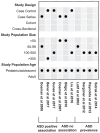Iron deficiency and common neurodevelopmental disorders-A scoping review
- PMID: 36173945
- PMCID: PMC9522276
- DOI: 10.1371/journal.pone.0273819
Iron deficiency and common neurodevelopmental disorders-A scoping review
Abstract
Background: A wealth of human and experimental studies document a causal and aggravating role of iron deficiency in neurodevelopmental disorders. While pre-, peri-, and early postnatal iron deficiency sets the stage for the risk of developing neurodevelopmental disorders, iron deficiency acquired at later ages aggravates pre-existing neurodevelopmental disorders. Yet, the association of iron deficiency and neurodevelopmental disorders in childhood and adolescence has not yet been explored comprehensively. In this scoping review, we investigate 1) the association of iron deficiency in children and adolescents with the most frequent neurodevelopmental disorders, ADHD, ASD, and FASD, and 2) whether iron supplementation improves outcomes in these disorders.
Method: Scoping review of studies published between 1994 and 2021 using "iron deficiency / iron deficiency anemia" AND "ADHD" OR "autism" OR "FASD" in four biomedical databases. The main inclusion criterion was that articles needed to have quantitative determination of iron status at any postnatal age with primary iron markers such as serum ferritin being reported in association with ADHD, ASD, or FASD.
Results: For ADHD, 22/30 studies and 4/4 systematic reviews showed an association of ADHD occurrence or severity with iron deficiency; 6/6 treatment studies including 2 randomized controlled trials demonstrated positive effects of iron supplementation. For ASD, 3/6 studies showed an association with iron deficiency, while 3/6 and 1/1 systematic literature review did not; 4 studies showed a variety of prevalence rates of iron deficiency in ASD populations; 1 randomized controlled trial found no positive effect of iron supplementation on behavioural symptoms of ASD. For FASD, 2/2 studies showed an association of iron deficiency with growth retardation in infants and children with prenatal alcohol exposure.
Conclusion: Evidence in favor of screening for iron deficiency and using iron supplementation for pediatric neurodevelopmental disorders comes primarily from ADHD studies and needs to be further investigated for ASD and FASD. Further analysis of study methodologies employed and populations investigated is needed to compare studies against each other and further substantiate the evidence created.
Conflict of interest statement
The authors have declared that no competing interests exist.
Figures





References
-
- GBD 2019 Mental Disorders Collaborators. Global, regional, and national burden of 12 mental disorders in 204 countries and territories, 1990–2019: a systematic analysis for the Global Burden of Disease Study 2019. Lancet Psychiatry. 2022. Feb;9(2):137–50. doi: 10.1016/S2215-0366(21)00395-3 - DOI - PMC - PubMed
Publication types
MeSH terms
Substances
LinkOut - more resources
Full Text Sources

